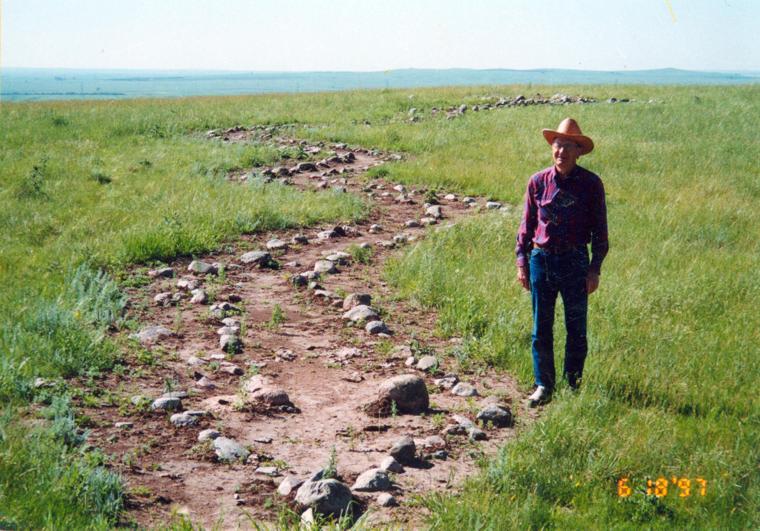
Courtesy of the South Dakota State Historical Society
Snake Effigy
In this 1997 photo, Royal Runge, the rancher who formerly owned the Medicine Knoll site from 1938 until 1999 and took care to preserve it, is shown here alongside the snake mosaic made of stones that archaeologists believe is close to 500 years old.
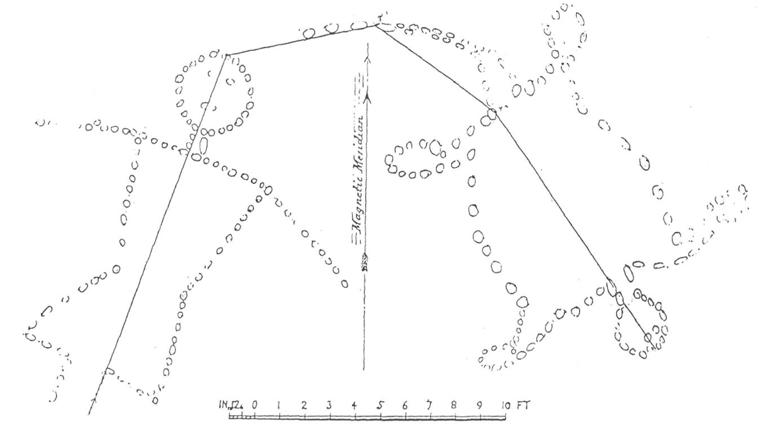
Image courtesy of Linea Sundstrom
Jerauld County effigy
1890 sketch by archaeologist T.H. Lewis of human and turtle effigies in Jerauld County. The human effigy was gone by 1982 and local tradition says the turtle was reconstructed by a troop of Boy Scouts in the 1930s.
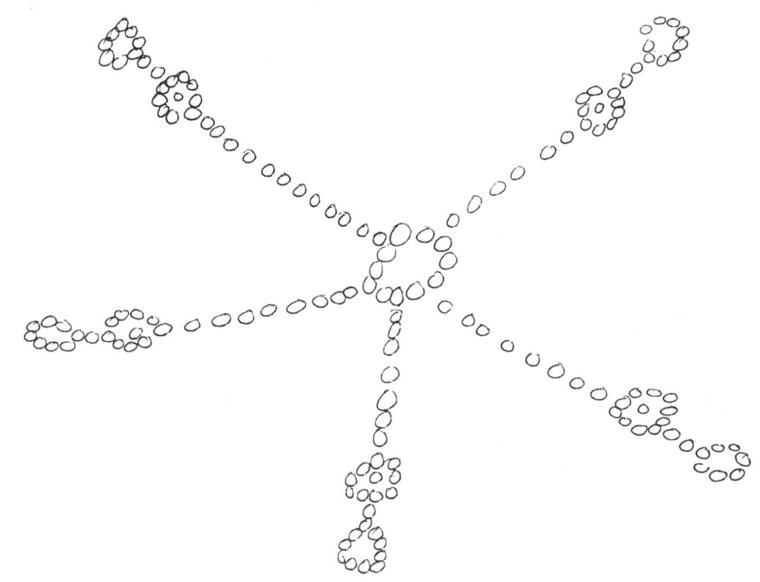
Image courtesy of Linea Sundstrom
Medicine Wheel
Medicine wheel reported in Custer County in 1949, but the exact location is unknown.

Image courtesy of Linea Sundstrom
Turtle effigy
Turtle effigy on Snake Butte in Hughes County. Oral history says the figure commemorates an Arikara warrior who was fatally wounded by a hostile band of Sioux, but managed to go nearly a mile in an attempt to warn his people.
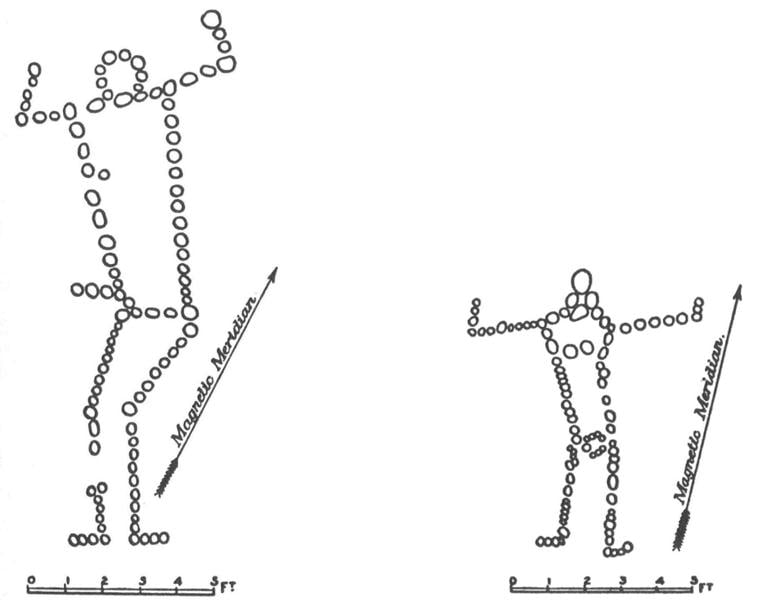
Image courtesy of Linea Sundstrom
Punished Woman Butte
Scale drawings of male and female figure that were part of an effigy on Punished Woman Butte in Codington County. Oral history said the figures represent lovers who were killed on the spot by a jealous husband.
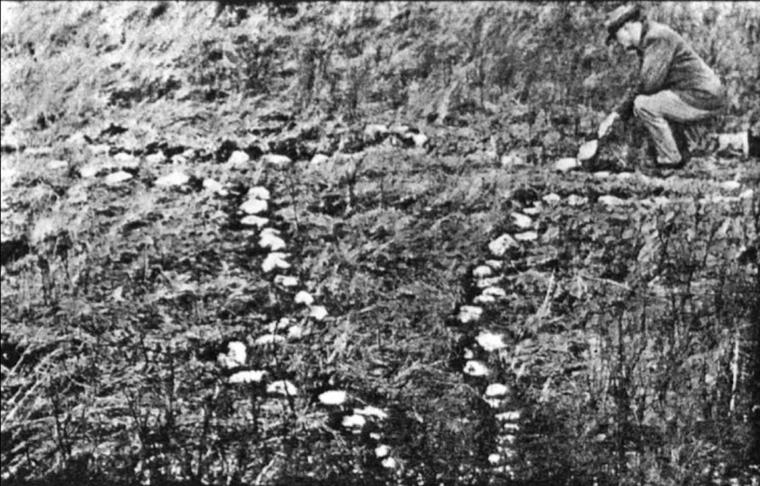
Image courtesy of Linea Sundstrom
Swan Effigy
Photo of an unidentified man kneeling alongside the swan effigy near Freeman. The picture ran in the June 1964 edition of “Wi-Iyohi,” the bulletin of the South Dakota State Historical Society.
Indian cliff paintings on the Mohawk River
“It was on the same shore, just east of the city, that the limestone
escarpment cited in the journal, itself a noteworthy feature of the riverside terrain, was observed. Although the Frenchmen
made no mention of seeing images on these rocks, another, passing
by a few months earlier, describes them:
This day we passed a rock projecting out of the bank
of the river, whereon was painted, with great ingenuity, in
red colours, a canoe with the representation of seven men
in it, which is said to be done annually by Indians, coming
several hundred miles for that purpose, in order to commemorate
the slaughter of seven Indians, who went off
from that neighborhood in some former wars, and were all
destroyed.
Jacob Lindley, 1793 16
As late as 1810, when DeWitt Clinton journeyed along this
waterway and recorded his observations, the images were still
visible:
About sixteen miles from Schenectady, we saw, on
the left bank of the river, a curious specimen of Indian
painting. On an elevated rock was painted a canoe, with
seven warriors in it, to signify that they were proceeding on
a war expedition. This was executed with red ochre, and
has been there for upwards of half a century.
DeWitt Clinton, 1810 17
Paintings of this type on rock were no doubt frequently made
by Native Americans since prehistoric times, but few could survive
more than a few years before they weathered away. Some
claimed the figures were “retouched,” which prolonged their life.
Others suggested a connection between these paintings and the
river boat traffic of the 1790s and early 1800s:
The Flat boatmen of the Mohawk held these rocks in
such reverence that they at times refreshed the paintings.
LaGrand Strang, 1887 18
That the images recalled so clearly in the early nineteenth century
were the product of various acts of “refreshing” is suggested
by the account of a visit to the site in 1796:
Stopped by the way at Miles’s (formerly Guy
Johnson’s house); there met a Dr. Sweet, who fell into conversation,
and offered to conduct us to the painted rock,
which he said was about two miles down the river. Took
him up in the carriage and rode with him two miles. Then
he and I left the carriage to search for the rock. This ramble
took up forty minutes, and I walked about two miles,
partly through woods and partly through fields.
The rock is on the north bank of the Mohawk, fifteen
miles above Skenectada. It is a perpendicular ledge of
limestone, with a pretty smooth surface and about twenty
feet high. On the upper part - which is easily accessible, the
laminae projecting in various places - appear the remains
of some red paint, which has been in the same situation for
eighteen or twenty years. Imagination may conceive the
paint to resemble almost any thing; but judgement cannot
decide without the help of testimony.
The tradition is that it was painted by the Indians in
memory of some canoes of Indians who went thence to
war, and never returned; that the painting represented
canoes and men in them; and that this painting is frequently
renewed to preserve the memory of the event. Some add
that the renewal is performed in the night, or by some
invisible hand. The fact is that there is a rock with some
appearance of red paint, that the paint has been in some
measure defended from the weather by a projection of the
rock over it, and that the place is easily accessible by similar
projections under it. This is all that can be said with
any certainty.
As to the frequent renewal of the paint, &c., I was
assured by Dr. Sweet that he had known it to be in the same
condition as we saw it for eighteen years past; and a man
whom we took as a pilot, who appeared to be abou
t twenty-
five years old, said it always looked just so since his
remembrance.
Jeremy Belknap, 1796 23
ibid p12-13
The drawings above, created one hundred years ago by Rufus Grider, have preserved for us an image of what the
Native American pictograph known as “Painted Rocks” must have looked like to passing boatmen. He based his
reconstruction on eyewitness interviews. At that time a number of persons could still recall the site in detail, and
related to him their recollections:
“Within the remembrance, possibly of some person still living, there was a large rock on the north shore
of the Mohawk, near Amsterdam, to be seen at low watermark, that contained Indian Memorials, such as the
figures of men and animals, and supposed by some to have been traced with red chalk, although they may have
been in vermilion, which the Whites bartered with the Natives for peltry.”
Jeptha Simms, 1882 19
“The rocks contained 12 or 15 Indians, with two canoes, two Indians in each canoe, one at the bow the
other at the stern, going west, other Indians on foot. A duck flying above eastward.”
John Winnie, 1887 20
“I lived all my life in the vicinity of the rocks. I lived on the south bank of the river when the canal was
made. Our house was just opposite the rocks and was the first house built [in] the present Port Jackson, and
is still standing. There were figures on the rocks, at least 9 in number, they were painted with red colors. My
grandfather was a soldier in the Revolutionary Army. He, when passing the rocks in a boat, was shot at by an
Indian who lay in ambush and wounded him. It was covered with pines and undergrowth.”
David DeForest, 1887 21
“I was born in Amsterdam in the year 1826 and lived there until I was 21 years old. I remember well the
painted rocks. I was very fond of being on the water; and before I was 14 years old I and another boy named
Abm. Pulling (now deceased) became owners of a rowboat, and in it passed many hours on the river, and
rowed past the painted rocks more times than I can remember. There were two canoes going upstream, as if
racing, with two Indians in each canoe. There were 10 or 12 Indians on the bank who were walking westward
and apparently watching the canoe race. The work was done in red paint, the figures were about 4 feet high,
and could be plainly seen from the opposite side of the river.
“... The pictures at that time had the appearance of being retouched, probably to perpetuate them. I think
they are now entirely obliterated. They were on the perpendicular face of the rocks which overlook the river, a
little east of the freight house and directly south of the Murphy Bros. warehouse. These tracings were of the
plainest and rudest kind.”
Moses T. Kehoo, 1887 22 ibid p13







